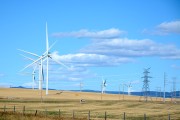Ontario's new Green Energy Act could unlock Ontario's green energy potential and set the province on the path to genuine global leadership.
To make this vision a reality, the legislation will need a concrete plan with aggressive targets and the right incentives, and the political will to break with old patterns.
The global shift to green energy recognizes that the old, centralized power systems that helped to build the post-war world are no longer suited to the imperatives and priorities of the 21st century. Worse yet these old systems can even work against modern green solutions.
In Ontario the current power system delivers electricity from mostly large fossil fuel, nuclear and hydro plants across great distances to homes and businesses. It is a system that creates unacceptable energy waste, air pollution, over-consumption, volatility and toxic waste. The system is ill-suited to meet the most pressing challenges.
We need a modern system that is more decentralized, efficient, cleaner and smarter.
Minister of Energy and Infrastructure, George Smitherman is to be congratulated for recognizing this in the design of the proposed Green Energy Act. But no matter how impressive this new green vehicle is, the important thing is where it takes us. As it stands now, this new visionary Green Energy Act stands in sharp contrast to the province's current electricity plan, which seems determined to build a future that looks like the past.
Ontario has already committed to phasing out dirty coal plants, and with all existing nuclear plants coming to the end of their working lives, we will have to replace three quarters of the existing system over the next two decades.
This creates a historic opportunity to truly transform the current electricity system. Here's the catch; the current electricity plan envisages only eight per cent of power coming from new green power sources like wind turbines and solar panels by 2027. This is nowhere near enough to attract the level of investment necessary to ensure a competitive green energy economy and develop a domestic green power industry.
To put this in perspective, the solar industry in Ontario would install over the next twenty years one fifth the number of panels that Germany has put up in a single year. Ontario would have significantly less wind capacity in 2027 than Texas already has today.
Meanwhile, half of Ontario's power is projected to come from new or re-built nuclear reactors. Indeed, Ontario's electricity plan actually halts construction of all new wind turbines in 2018, in order to leave space for the new reactors that the province is considering purchasing.
This needs to change. Otherwise the Green Energy Act will simply be a vehicle to usher in renewable energy plans already on the table, rather than serve the expansion of green energy.
Fortunately, Minister Smitherman rejected the current electricity plan in September and ordered the Ontario Power Authority to develop a new one, which is due to be released in the coming weeks. This new plan will be made public as the Green Energy Act is still being debated. A key part of this plan - because it is a decision that must be made this year - is how the province will replace Pickering B, one of Ontario's oldest nuclear stations that starts coming off-line in four years.
Replacing Pickering B with renewable energy, clean distributed power, conservation and efficiency would be a real test of the reach and success of the new Green Energy Act.
A growing chorus of energy specialists support the idea; even the province's system operator suggested in its December report that this is a viable choice. Studies show that there is more than enough cost-effective, quick-to-deploy green energy available to replace Pickering B's 2,000 MW-baseload equivalent.
Choosing green over nuclear will also avert the looming electricity gap projected if we are to wait for new nuclear to come online. This gap will have to be filled with fossil fuels, according to the Ontario Power Authority. Going green instead of nuclear will reduce Ontario's greenhouse gas emissions, especially in the immediate term, which is most critical to avert dangerous climate change.
Meeting today's challenges and building a new energy future means making bold and visionary choices. We cannot spend the same energy dollar twice, and we must therefore choose whether we will spend money keeping our old system on life support, or whether we will begin to build a new dynamic system and participate in the new green prosperity.
The Green Energy Act and the Pickering B decision will be clear indicators of Ontario's choice, and future direction.
Cherise Burda is Director of Ontario Energy Solutions for the Pembina Institute. Her reports on sustainable energy can be found at www.renewableisdoable.org.
Joslyn Higginson is the owner of Manifesto Sustainability Communications.






